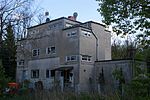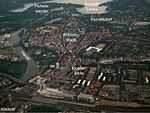Staaken Garden City

The Staaken Garden City is a housing estate located in the Berlin district of Spandau next to the old village of Staaken. It was built between 1914 and 1917 according to the design of the architect Paul Schmitthenner. It is considered one of the most significant urban development achievements of the early 20th century because of the layout of the streets and squares, the intelligent handling of house types and variations, and especially because of its model effect on the Berlin housing estates of the 1920s. The Staaken Garden City was planned with 1000 apartments and a number of public buildings for 5000 inhabitants. Unlike most other projects of this type, size and construction period, it was completed almost entirely within four years according to the original design.
Excerpt from the Wikipedia article Staaken Garden City (License: CC BY-SA 3.0, Authors, Images).Staaken Garden City
Am Heideberg, Berlin Staaken
Geographical coordinates (GPS) Address Nearby Places Show on map
Geographical coordinates (GPS)
| Latitude | Longitude |
|---|---|
| N 52.540833333333 ° | E 13.146944444444 ° |
Address
Am Heideberg 13
13591 Berlin, Staaken
Germany
Open on Google Maps









